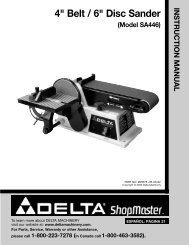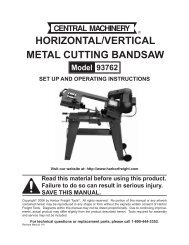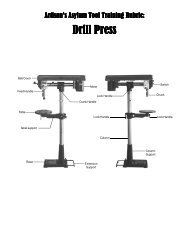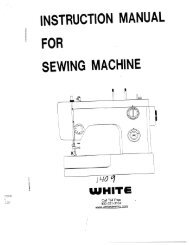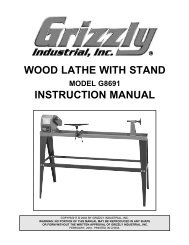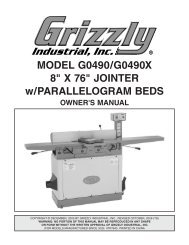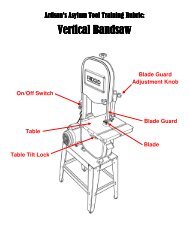You also want an ePaper? Increase the reach of your titles
YUMPU automatically turns print PDFs into web optimized ePapers that Google loves.
OPERATION<br />
WARNING:<br />
Do not allow familiarity with tools to make you<br />
careless. Remember that a careless fraction of a<br />
second is sufficient to inflict severe injury.<br />
WARNING:<br />
Always wear safety goggles or safety glasses with<br />
side shields during power tool operation or when<br />
blowing dust. If operation is dusty, also wear a<br />
dust mask.<br />
WARNING:<br />
To avoid blade contact, adjust the blade guide<br />
assembly to just clear the workpiece. Failure to<br />
do so could result in serious personal injury.<br />
APPLICATIONS<br />
You may use this tool for the purposes listed below:<br />
• Scroll cutting and circle cutting of wood and wood composition<br />
products<br />
• Relief cutting of wood and wood composition products<br />
BASIC OPERATION OF THE BAND SAW<br />
A band saw is basically a “curve cutting” machine that can<br />
also be used for straight-line cutting operations like cross<br />
cutting, ripping, mitering, beveling, compound cutting, and<br />
resawing. It is not capable of making inside or non-through<br />
cuts.<br />
This band saw is designed to cut wood and wood<br />
composition products only.<br />
Before starting a cut, watch the saw run. If you experience<br />
excessive vibration or unusual noise, stop immediately. Turn<br />
the saw off, remove the switch key, and unplug the saw. Do<br />
not restart until locating and correcting the problem.<br />
CUTTING PROCEDURES<br />
• Hold the workpiece firmly against the saw table.<br />
• Use gentle pressure and both hands when feeding the<br />
work into the blade. Do not force the work; allow the<br />
blade to cut.<br />
• The smallest diameter circle that can be cut is determined<br />
by blade width. A 1/4 in. (6 mm) wide blade will cut a<br />
minimum diameter of 1-1/2 in. (38 mm); a 1/8 in. (3 mm)<br />
wide blade will cut a minimum diameter of 1/2 in. (13<br />
mm).<br />
• Keep your hands away from the blade. Do not hand<br />
hold pieces so small your fingers will go under the blade<br />
guard.<br />
• Avoid awkward operations and hand positions where a<br />
sudden slip could cause serious injury from contact with<br />
the blade. Never place hands in blade path.<br />
• Use extra supports (tables, saw horses, blocks, etc.) when<br />
cutting large, small or awkward workpieces.<br />
• Never use a person as a substitute for a table extension<br />
or as additional support for a workpiece that is longer or<br />
wider than the basic saw table.<br />
• When cutting irregularly shaped workpieces, plan your<br />
work so it will not pinch the blade. For example, a piece<br />
of molding must lay flat on the saw table. Workpieces<br />
must not twist, rock or slip while being cut.<br />
When backing up the workpiece, the blade may bind in<br />
the kerf (cut). This is usually caused by sawdust clogging<br />
the kerf or when the blade comes out of the guides. If this<br />
happens:<br />
• Wait until the saw has come to a full and complete<br />
stop.<br />
• Place the switch in the OFF (O) position then remove the<br />
switch key from the switch assembly. Store key in a safe<br />
place.<br />
• Unplug the saw from the power source.<br />
• Wedge the kerf open with a flat screwdriver or wooden<br />
wedge.<br />
• Open front cover and turn the upper wheel by hand while<br />
backing up the workpiece.<br />
RELIEF CUTS<br />
Relief cuts are made when an intricate curve (too small a<br />
radius for the blade) is to be cut. Cut through a scrap section<br />
of the workpiece to curve in pattern line then carefully back<br />
the blade out. Several relief cuts should be made for intricate<br />
curves before following the pattern line as sections are cutoff<br />
of curve “relieving” blade pressure.<br />
SCROLL CUTTING<br />
For general type scroll cutting, follow the pattern lines by<br />
pushing and turning the workpiece at the same time. Do not<br />
try to turn the workpiece while engaged in the blade without<br />
pushing it – the workpiece could bind or twist the blade.<br />
REMOVING JAMMED MATERIAL<br />
Never remove jammed cutoff pieces until the blade has come<br />
to a full and complete stop.<br />
• Place the switch in the OFF (O) position, remove the<br />
switch key from the switch assembly.<br />
• Unplug the saw from the power source before removing<br />
jammed material.<br />
25



